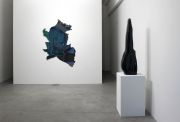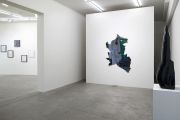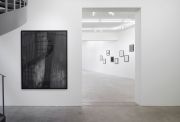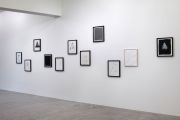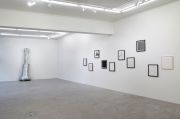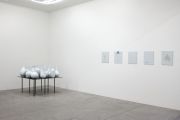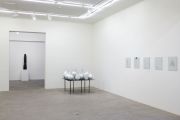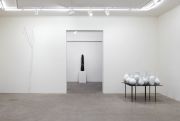Not Vital
Che fasch?
12.9.- 2.11. 2019
Galerie Urs Meile Lucerne
Press Release – English
In Not Vital’s art, everything is out of place, yet precisely where it belongs. A bone from the South Pacific is enlarged to ten times its size in China and transformed into a sculptural barometer made from aluminum. The surreal sculpture is then filled with water before it is placed into the exhibition setting. All the countries beginning with the letter ‘P’ are removed from the world map and regrouped. Looking at this new and apparently perfect constellation, we wonder why these countries haven’t been next to each other all along. A mountain peak from the Alpine valley of Engadin in Switzerland, Vital’s homeland, is drawn in Rio de Janeiro’s scorching heat, using white silicone on black foam. Never has this mountain peak looked so cool and snow-capped.
For about 50 years now, Vital has been leading an almost nomadic life that takes him from one continent to the next. His current studios are located in Sent (Switzerland), Rio de Janeiro (Brazil), and Beijing (China). Driven by an apparently insatiable desire to explore far-flung lands, their cultures and their crafts, Vital dives into new worlds with astonishing ease. Working in often remote, hard-to-access regions, he employs local artisan techniques and regional resources to undertake projects that are as mobile as he is himself: both in their visual language and their technical realization. In cadence with Vital’s itinerant way of life, his art migrates instinctively between non-European and local allegories. A pinch of alchemy is all it takes for the exotic to become domesticated and for the local-mundane to be transformed into something extraordinary through surreal and minimalist visual vocabulary.
Not Vital’s fourth exhibition with Galerie Urs Meile poses a question for its title: “Che fasch?” is Romansh and means “What are you doing?”. The twenty-two works that are on display in the rooms of the gallery’s Lucerne-based branch provide insight into Vital’s artistic methods and practice.
Displayed next to Vital’s early, large-format work Untitled (1986, mixed media on paper, 192 x 152.5 cm) which dates back to 1986, is Countries with a P (2019, stainless steel, 200 x 135 x 5 cm). While the first is a dark, abstract drawing that with its expressive quality bears witness to Vital’s early years in New York, Countries with a P is a recent piece that Vital materialized at his studio in Beijing, like all his stainless steel sculptures. The eight countries whose names begin with a ‘P’ – Pakistan, Peru and Panama, to name three – have been assembled to form a sculptural constellation that, in its utopian ambition, mocks the arbitrary nature of the world map.
Family of Sixteen – Two Identical Twins (2017, 16 ceramic vases of varying sizes; iron table, 70 x 140 x 140 cm) is an installation consisting of sixteen ceramic vases standing in kinship on an iron table. For nearly ten years now, Vital has been producing ceramic in the historic city of Jingdezhen, situated in southeast China. While most of his ceramic works are sculptures of often monumental proportions, this piece is based on the strategy of the ‘ready-made’, also paying homage to the craftsmanship of the local ceramic makers: the work comprises sixteen vases that Vital found in their workshops.
4 Steps, Stronzel and Mountain (all 2018, ceramic, each 45 x 36 cm) are good examples of Vital’s ability to transfigure the local and mundane: familiar symbols or Romansh expressions are transcribed into ceramic in China to appear thereafter in the exhibition space as sculptural wall objects.
While Vital’s works in stainless steel or even ceramic arise from a complex, protracted manual process, drawing is a swift medium that Vital often uses while traveling and to record emotions, ideas or even symbols. Sporting a hearty dose of surrealist humor, Vital creates drawings that often transcend the two-dimensional in their astonishing use of materials. Vital’s works on paper incite us to see both the medium of drawing as well as the portrayed subject matters with fresh eyes: the mountain outside Vital’s studio in Sent materializes in silicone on black foam; black sandpaper evokes the murky, dark ice of the Engadin’s mountain lakes.
Nothing (2012, bronze with white patina, 360 x 70 x 30 cm) is a branch cast in bronze and finished with white patina. Seven letters sit perched on the branch’s tips, together forming the word “Nothing”. Nothing is perhaps Vital’s best answer to the question “Che fasch?”: when someone asks him what he’s
doing, the artist likes to refer to the Taoist concept of wuwei, which translates as “non-doing”. Wuwei, however, is not to be confused with inaction or idleness; it is a state of inner peace based on intuition and savoir-faire. Vital’s fascination with Far Eastern philosophy illustrates quite clearly that his mobility is not only physical or geographical, but of spiritual nature as well.
Not Vital (1948) was born in the mountain village of Sent in the Engadin Valley, and is an internationally acclaimed sculptor and painter. He lives and works in Sent (Switzerland), Rio de Janeiro (Brazil) and Beijing (China). Vital is an unusual sculptor in many ways, not least because he also paints, sketches and produces wonderful prints. Since the early 2000s, his practice has expanded to include buildings such as houses, schools, towers, bridges and tunnels, which blur the boundaries between art and architectures. These structures, which Vital subsumes under the self-coined term of SCARCH (Sculpture-Architecture), are often to be found in remote locations: in the Chilean Patagonia, the Brazilian Amazon, or the island of Flores in Indonesia.
Vital’s most recent solo exhibitions have taken place at the Ateneum, Helsinki (2018); the Bündner Kunstmuseum, Chur (2017); the Yorkshire Sculpture Park, Wakefield (2016); and the Museo d’Arte di Mendrisio (2015). In 2001, Vital took part in the 49th Venice Biennale, curated by Harald Szeemann. His
works are included in numerous public collections at, for example, the Carnegie Institute, Pittsburgh; the Dallas Museum of Art, Dallas; the Solomon R. Guggenheim Museum, New York City; the Kunstmuseum Bern, Bern; the Kunstmuseum Chur, Chur; the Kunsthalle Bielefeld, Bielefeld; the Museum der Moderne, Salzburg and The Museum of Modern Art, New York City.
Giorgia von Albertini
Press Release – Deutsch
In Not Vitals Kunst ist alles deplatziert, und dennoch am richtigen Ort. Ein Knochen aus dem Südpazifik wird in China auf das zehnfache vergrössert und in einen skulpturalen Barometer aus Aluminium verwandelt. Folglich wird die surreale Skulptur mit Wasser gefüllt und findet ihren Platz im
Ausstellungsraum. Alle Länder, deren Namen mit einem P beginnen werden der Weltkarte entnommen und neu gruppiert. Angesichts dieser neuen und scheinbar perfekten Konstellation fragt man sich, weshalb diese Länder nicht schon immer nebeneinander Platz nahmen. Eine Bergspitze aus Vitals heimischem Engadin wird in Rio de Janeiro bei brütender Hitze mit weissem Silikon auf schwarzen Schaumstoff gemalt. Noch nie sah die Bergspitze schneebedeckter und kühler aus.
Seit rund 50 Jahren führt Vital ein nahezu nomadisches Leben, das ihn von einem Kontinent zum nächsten führt. Seine derzeitigen Ateliers befinden sich in Sent (Schweiz), Rio de Janeiro (Brasilien), und Peking (China). Angetrieben von einem scheinbar unersättlichen Drang, die weite Ferne, deren Kulturen und deren Handwerk zu erkunden, taucht Vital mit erstaunlicher Leichtigkeit in neue Welten ein. In zumeist abgelegenen, schwer erreichbaren Regionen verwendet er Techniken der lokalen Handwerkskunst und realisiert mittels Rückbezug auf regionale Ressourcen Projekte, die in ihrer
Bildsprache und Materialisierung ebenso mobil sind wie er selbst. Im Gleichschritt mit Vitals nomadischem Lebenswandel migriert seine Kunst traumwandlerisch zwischen aussereuropäischen und heimischen Sinnbildern. Mit leichtfüssiger Alchemie wird das Exotische domestiziert und das Lokal- Alltägliche mittels surreal-minimalistischer Bildsprache in etwas Aussergewöhnliches verwandelt.
Not Vitals vierte Ausstellung mit der Galerie Urs Meile trägt als Titel eine Frage: «Che fasch?» ist Romanisch und heisst «Was machst Du?». In den Räumlichkeiten des Luzerner Ablegers der Galerie sind 22 Arbeiten versammelt, die Einblick in die künstlerische Praxis Vitals gewähren.
Neben einem frühen, grossformatigen Werk Untitled (1986, mixed media on paper, 192 x 152.5 cm) aus dem Jahre 1986, hängt Countries with a P (2019, stainless steel, 200 x 135 x 5 cm). Während die dunkle und abstrakte Zeichnung wegen ihrer expressiven Qualität von Vitals Anfangsjahren in New York zeugt, ist Countries with a P ein aktuelles Werk, welches Vital, wie alle seine Skulpturen aus rostfreiem Stahl, in seinem Atelier in Beijing materialisiert hat. Die acht Länder, deren Namen mit einem P beginnen, wie etwa Pakistan, Peru und Panama, sind zu einer skulpturalen Konstellation zusammengefügt, die in ihrer utopischen Ambition die Arbitrarität der Weltkarte mokiert.
Family of Sixteen – Two Identical Twins (2017, 16 ceramic vases in varying sizes; iron table, 70 x 140 x 140 cm) ist eine Installation, welche aus sechzehn Keramikvasen besteht, die in
verwandtschaftlicher Nähe auf einem Eisentisch stehen. Seit bald zehn Jahren macht Vital in Jingdezhen, einer geschichtsträchtigen Stadt im Südosten Chinas Keramik. Während die meisten seiner Arbeiten aus Keramik Skulpturen in oftmals monumentalen Dimensionen sind, basiert dieses Werk auf der Strategie des Readymades und ist zugleich eine Hommage an die Handwerkskunst der lokalen Keramik-Macher: das Werk setzt sich aus 16 Vasen zusammen, die Vital in deren Werkstätte gefunden hat.
4 Steps, Stronzel und Mountain (alle 2018, ceramic, 45 x 36 cm) stehen exemplarisch für Vitals Vermögen, das Lokal-Alltägliche zu transformieren: heimische Symbole oder romanische Ausdrücke werden in China in Keramik realisiert, und erschienen sodann als skulpturale Wandobjekte im
Ausstellungsraum.
Während Vitals Arbeiten in rostfreiem Stahl oder auch in Keramik aus einem komplizierten und langwierigen handwerklichen Prozess hervorgehen, ist das Zeichnerische ein schnelles Medium, welches Vital oftmals auf Reisen nutzt, um Emotionen, Ideen oder auch Symbole festzuhalten. Mit einer guten Dosis surrealistischem Humor ausgestattet, kreiert Vital Zeichnungen, die ihrer erstaunlichen materiellen Zusammensetzung wegen oftmals über das Zweidimensionale hinausgehen.
Vitals Arbeiten auf Papier verleiten uns dazu, sowohl das zeichnerische Medium, als auch die abgebildeten Sujets mit frischem Blick zu sehen: der Berg vor Vitals Atelier in Sent materialisiert mittels Silikon auf schwarzem Schaumstoff, schwarzes Schleifpapier erinnert an das dunkelschwarze Eis der Engadiner Bergseen.
Nothing (2012, bronze with white patina, 360 x 70 x 30 cm) besteht aus einem Ast, den Vital in Bronze gegossen und weiss patiniert hat. Auf den Astspitzen sitzen sieben Buchstaben, die gemeinsam das Wort «Nothing» formen. Nothing ist wohl auch Vitals beste Antwort auf die Frage «Che fasch?»: gerne verweist der Künstler auf das daoistische Konzept WuWei, welches soviel heisst wie «Nichtstun», wenn ihn jemand fragt, was er denn tue. WuWei ist jedoch nicht als Tatenlosigkeit oder Faulheit zu verstehen, sondern vielmehr als Zustand innerer Ruhe, welcher auf Intuition und savoir-faire beruht. Vitals Faszination für die fernöstlichen Philosophie verdeutlicht, dass seine Mobilität nicht nur eine physisch-geographische ist, sondern auch eine geistliche.
Not Vital (1948) wurde im Bergdorf Sent im Engadin geboren und ist ein international bekannter Bildhauer und Maler. Er lebt und arbeitet in Sent (Schweiz), Rio de Janeiro (Brasilien) und Peking (China). Vital ist in vielerlei Hinsicht ein ungewöhnlicher Bildhauer, nicht nur weil er auch malt, zeichnet, und wundervolle Drucke produziert, sondern auch weil er seit rund 20 Jahren monumentale Skulpturen realisiert, mit welchen er die Trennung zwischen den Disziplinen der Skulptur und der Architektur als obsolet erklärt. Diese Strukturen, welche Vital unter dem selbst geprägten Terminus SCARCH (Sculpture-Architecture) subsumiert, finden sich in oftmals abgelegenen Orten, wie etwa im chilenischen Patagonia, dem Amazonas in Brasilien, oder auch der Insel Flores in Indonesien.
Vitals aktuellste Einzelausstellungen fanden im Ateneum, Helsinki (2018); Bündner Kunstmuseum, Chur (2017); Yorkshire Sculpture Park, Wakefield (2016); und im Museo d’Arte di Mendrisio (2015) statt. In 2001 partizipierte Vital an der von Harald Szeemann kuratierten 49ten Biennale von Venedig. Seine Arbeiten sind Teil zahlreicher öffentlicher Sammlungen, wie etwa dem Carnegie Institute, Pittsburgh; Dallas Museum of Art, Dallas; Solomon R. Guggenheim Museum, New York City; Kunstmuseum Bern, Bern;
Kunstmuseum Chur, Chur; Kunsthalle Bielefeld, Bielefeld; Museum der Moderne, Salzburg und The Museum of Modern Art, New York City.
Giorgia von Albertini
Downloads
Press Release (English, PDF)
Press Release (Deutsch, PDF)
Events
Opening:
Thursday, September 12, 2019, 5.30 - 7.30pm

